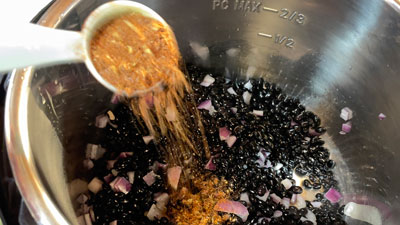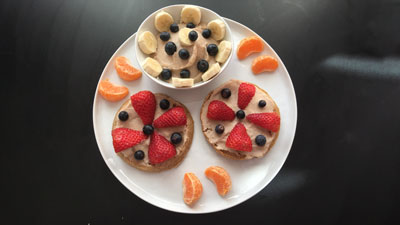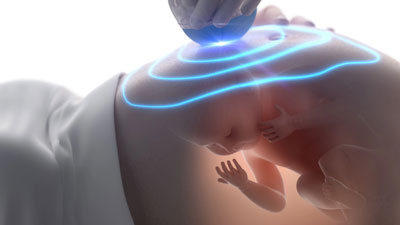
These “common beans” from Central and South America are anything but common. They are extraordinary when it comes to their effects on our heart, brain, digestion, immune system, muscles, bones, and overall health. Not only are they a top source of fiber, protein and omega-3s, they also provide a high amount of minerals and B vitamins, including folate. Plus, beans are rich in phytochemicals that support our immune system, help us fight inflammation and free radicals, and even promote our longevity!
The color of each of these beans gives them specific superpowers: white beans are a great source of calcium and potassium, red kidney beans have high amounts of longevity phytochemical, quercetin; pinto beans have the highest amount of folate, and black beans are a great source of anthocyanins. So, be sure to include them all in your family’s diet. They also have different flavors and consistencies that help us create a nice variety of dishes, from traditional tacos or bean soups, to sweet potato quesadillas, veggie paddies, black-bean pasta, or bean spreads.
What about their explosive effect? So many people avoid beans because of this, but in most cases, gas is caused by not having the right gut bacteria to process them. The more we eat beans and legumes, the more of the right bacteria we will grow, and the easier it will be for our little guys to help us digest our beans. So, start small and take it from there. Concerned about lectins? Don’t be. Soaking your beans before boiling them, or cooking them in your pressure cooker for over 45 minutes, will eliminate most of them.
Check out our interactive page to learn more about how these extraordinary beans can support your family’s well being.
Beans Nutrition Calculator:
Use our personalized nutrition calculator to discover the percentage of daily nutrition needs you and your family can get from eating black beans, pinto beans, red kidney beans, or white beans. We’ve made separate calculators for boiled vs canned beans because there is a difference in nutritional content.
Nutrition needs vary according to age, sex, and whether women of reproductive age are pregnant or breastfeeding. Fill out the form below for yourself and for your family members to get personalized results.*
* Calculated as a percentage of the Recommended Daily Allowances (RDAs) as established by the U.S. Department of Agriculture and the U.S. Department of Health and Human Services. Based on nutritional information provided by the U.S. Department of Agriculture as an average of multiple beans samples.
Tips to Select and Prepare Your Beans
Organic or Not?

According to the Environmental Working Group (EWG), beans and legumes are often sprayed with glyphosate right before harvest. Aside from avoiding this chemical that is linked to a higher risk of cancer, organic beans also have a higher nutritional profile than their conventional counterpart, including 20% more protein, 28% more antioxidant power, and 10% less phytate. Learn more.
Sort and Rinse Before Cooking

Beans are left to dry in the field, so they often come with some small rocks, dirt or organic debris. This is why sorting your beans is important. Simply spread your beans on a light-colored surface so you can easily scan for debris, or slowly transfer small handfuls from one hand to the other while inspecting them. After you sort your beans, rinse them in a large colander to remove dirt.
To Soak or Not to Soak

Soaking our beans can help shorten their cooking time while also reducing their lectin content. After sorting and rinsing your beans, soak them for at least five hours and then cook them for about 20 mins. in your pressure cooker or 45 mins. on your stove. You can also skip this step and simply cook for 40-45 mins. in the pressure cooker or about an hour on the stove to destroy those lectins.
Spice Up Your Beans

Add more flavor and antioxidant power to you beans while cooking them. Dry-sauté a diced onion until caramelized, then use a little water to pick up the flavors. Then, add 3 cups of rinsed beans and 3 tablespoons of your favorite spice mix. This Fajita Seasoning is delicious, you can eliminate or reduce the salt amount and skip the sugar. Add about 8 cups of water and cook them on the stove or pressure cooker.
Skip the Unhealthy Companions

Skip the unhealthy companions such as meat, dairy or oil. If you like refried beans, just mash your boiled beans with a fork. If you like to give them a cheesy flavor, add nutritional yeast. And if you enjoy eating them with tortilla chips, try an oil-free brand or make your own. Cut your oil-free tortillas in eights, spread them on a baking pan, sprinkle lemon or lime juice and spices, and bake at 250°F until crisp (about 30 minutes) flipping them once.
Beans for Breakfast

A lot of cultures eat beans for breakfast, whether it is black beans with Mexican chilaquiles, or some delicious hummus with vegetables or pita bread. If you prefer a sweet breakfast, try out this delicious recipe from Forks Over Knives. All it takes is white beans, plant-based milk, maple syrup (or dates), vanilla, and cinnamon. Serve in a bowl or spread on some toast, add fruits and enjoy!
How Beans Support Our Body
Beans are one of the most nutritious food groups, with benefits to all of our body parts. Hover over each pointer below to see how each body part uses the various nutrients present in common beans. Click on a pointer to visit that body part’s interactive page with further information about the nutrients it needs to thrive, the best whole-food plants to find them, and some interesting facts.
Important Things to Know
Hover over each of the facts below to flip the tiles and learn more details!
Black vs Pinto vs Red Kidney vs White
All four types of beans are incredibly nutritious and an important part of a whole-foods, plant-based diet. However, they each have different strengths, so you should aim to include them all in your meals rotation. See the comparison chart below to easily spot their strongest nutrition suit!




References








